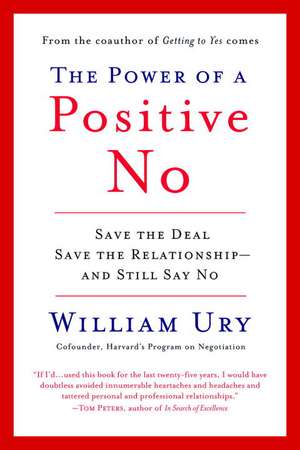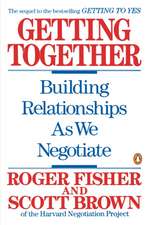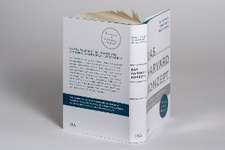The Power of a Positive No
Autor William Uryen Limba Engleză Paperback – 31 dec 2007
But as we all know, the wrong No can also destroy what we most value by alienating and angering people. That’s why saying No the right way is crucial. The secret to saying No without destroying relationships lies in the art of the Positive No, a proven technique that anyone can learn.
This indispensable book gives you a simple three-step method for saying a Positive No. It will show you how to assert and defend your key interests; how to make your No firm and strong; how to resist the other side’s aggression and manipulation; and how to do all this while still getting to Yes. In the end, the Positive No will help you get not just to any Yes but to the right Yes, the one that truly serves your interests.
Based on William Ury’s celebrated Harvard University course for managers and professionals, The Power of a Positive No offers concrete advice and practical examples for saying No in virtually any situation. Whether you need to say No to your customer or your coworker, your employee or your CEO, your child or your spouse, you will find in this book the secret to saying No clearly, respectfully, and effectively.
In today’s world of high stress and limitless choices, the pressure to give in and say Yes grows greater every day, producing overload and overwork, expanding e-mail and eroding ethics. Never has No been more needed. A Positive No has the power to profoundly transform our lives by enabling us to say Yes to what counts–our own needs, values, and priorities.
Understood this way, No is the new Yes. And the Positive No may be the most valuable life skill you’ll ever learn!
From the Hardcover edition.
| Toate formatele și edițiile | Preț | Express |
|---|---|---|
| Paperback (2) | 61.20 lei 3-5 săpt. | +28.57 lei 4-10 zile |
| HODDER AND STOUGHTON LTD – 3 apr 2008 | 61.20 lei 3-5 săpt. | +28.57 lei 4-10 zile |
| Bantam – 31 dec 2007 | 100.44 lei 3-5 săpt. | +26.73 lei 4-10 zile |
Preț: 100.44 lei
Nou
19.22€ • 19.99$ • 15.87£
Carte disponibilă
Livrare economică 25 martie-08 aprilie
Livrare express 08-14 martie pentru 36.72 lei
Specificații
ISBN-10: 0553384260
Pagini: 257
Ilustrații: ILLUSTRATED WITH DIAGRAMS T/O
Dimensiuni: 140 x 215 x 15 mm
Greutate: 0.23 kg
Editura: Bantam
Colecția Bantam Books
Notă biografică
From the Hardcover edition.
Extras
Uncover Your Yes
“In creating, the only hard thing’s to begin; a grass-blade’s no easier to make than an oak.” –James Russell Lowell
Perhaps the single biggest mistake we make when we say No is to start from No. We derive our No from what we are against–the other’s demand or behavior. A Positive No calls on us to do the exact opposite and base our No on what we are for. Instead of starting from No, start from Yes. Root your No in a deeper Yes–a Yes to your core interests and to what truly matters.
Nowhere did I learn this more clearly than from a relative of mine who suffered from a serious addiction to alcohol that nearly cost him and others their lives in a car accident. He tried many times to give up the habit but always failed. Then at the age of sixty, just when all hope seemed lost, he found in him- self the will to say No and stop drinking. The secret? “When my first grandchild was born,” he says, “I wanted more than anything to live long enough to see him grow up. It was his birth that motivated me to get treatment and stop drinking. Since then, for over fifteen years now, I have not touched a drop.” His Yes to being present for his grandchildren–to be able to play with them and see them grow–motivated his powerful No to alcohol.
His story serves to illustrate an everyday paradoxical truth: the power of your No comes directly from the power of your Yes.
Your Yes is the underlying purpose for which you are saying No. The first step in the method is to uncover the Yes that lies behind your No. The deeper you go into your core motivation, the more powerful your Yes will be and thus the more powerful your No.
From Reactive to Proactive
The biggest obstacle to saying No successfully is not the other, however difficult they might be. It is ourselves. It is our all-too-human tendency to react–to act with intense emotion but without clear purpose. We humans are reaction machines. And our Nos tend to be reactive. We accommodate out of fear and guilt. We attack out of anger. We avoid out of fear. To get ourselves out of this three-A trap, we need to become proactive, forward-looking, and purposeful.
This challenge is vividly captured in an old Japanese story about a samurai and a fisherman. One day, the samurai went to collect a debt from the fisherman. “I’m sorry,” the fisherman said, “but this last year has been a very bad one for me, and I regret to say I do not have the money to repay you.” Quick to anger, the samurai drew his sword and prepared to kill the fisherman on the spot. Thinking fast, the fisherman boldly said, “I have been studying martial arts and my master teaches that you should never strike out of anger.”
The samurai looked at him for a minute, then slowly lowered his sword. “Your master is wise,” he said quietly. “My master used to teach the same lesson. Sometimes my anger gets the better of me. I will give you one more year to repay your debt, but if you fail by even a penny, I will surely kill you.”
The samurai returned to his house, arriving late at night. He crept in quietly, not wishing to wake his wife, but to his shock, he found two people in the bed, his wife and a stranger dressed in samurai clothing. With a surge of jealousy and anger, he raised his sword to slay them both, but suddenly the fisherman’s words came back to him: “Do not strike out of anger.” The samurai stopped for a moment, took a deep breath, and then deliberately made a loud noise. His wife instantly woke up, as did the “stranger,” who turned out to be his mother.
“What is the meaning of this?” he yelled. “I almost killed you both!”
“We were afraid of robbers,” his wife explained. “So I dressed your mother up in your samurai clothes to scare them off.”
A year passed and the fisherman came to see the samurai. “I had an excellent year, so here is your money back and with interest,” the fisherman said happily to him.
“Keep your money,” replied the samurai. “You repaid your debt long ago.”
When you want to say No, remember the samurai’s lesson: do not react out of anger–or indeed out of any negative emotion such as fear or guilt. Take a deep breath and focus on your purpose–your Yes–in this situation. Ask yourself what you really want and what is really important here. In other words, shift from being reactive focused on No, to being proactive focused on Yes.
This chapter outlines a process that can help you. As the samurai did, you start by stopping and collecting your wits. You then proceed to ask yourself why. Why do you want to say No? What are your underlying interests, needs, and values? Once you have answered this question, you can then crystallize your Yes!–your intention to protect what matters most to you.
Stop: Go to the Balcony
We do not have a chance of being able to influence the other unless we are first able to control our own natural reactions and emotions.
When we want to say No to an offensive behavior or inappropriate demand, it is only natural to feel angry. But anger can blind us. In the rush to say No, angrily and sometimes vengefully, it is all too easy to lose sight of the prize–advancing our interests. Fear too can prevent us from pursuing our objectives. We imagine in advance the other’s reaction to our No. What will they think of us or do to us? What will happen to our relationship, to the deal, and thus to our interests? Paralyzed, we accommodate, giving up on our needs. Guilt has a similar effect. “Who am I to say No?” “I don’t deserve the time to myself.” “Their needs are more important than mine.”
Anger can blind, fear can paralyze, and guilt can weaken.
The first challenge we face, therefore, is internal. Recall the example of the man who said No to his domineering father, who was also his boss. In John’s own words, “I didn’t stand up to my dad, I stood up to my fears!” As John recognized, the real obstacle to getting what he wanted was not his father; it was his own fears. “All the action was basically over by the time I spoke to him.” That is the key point. The real action of standing up for yourself takes place inside you before you say No.
This internal action starts with stopping. Stopping is all- important because it interrupts your natural reaction, buys you time to think, and thus allows you to uncover your Yes. You may stop for a second, an hour, a day, or however long is required. What matters is to stop and get some perspective on the situation before proceeding with your No.
I like to use the metaphor of “going to the balcony.” The balcony is a detached state of mind you can access anytime you choose. Imagine yourself for a moment as an actor on a stage about to speak your lines–your No. Now picture yourself up on a balcony overlooking the stage, a place where you can see the scene clearly from afar. The balcony is a place of perspective, calm, and clarity. From a balcony perspective, it is much easier to uncover the Yes behind your No.
I came to truly appreciate this lesson when I was asked to facilitate a difficult discussion in the mid-1990s between Russian and Chechen leaders about how to end the tragic war in Chechnya. This discussion took place at the Peace Palace in The Hague in the very same conference room used for the international tribunal on war crimes in the former Yugoslavia. The Chechen vice president began his long speech by making a series of vociferous accusations against the Russians, saying they should stay in that room because they themselves would soon be on trial for war crimes. He then turned to me and, looking me right in the eye, began attacking: “You Americans have been supporting the Russians in their war crimes! And, what is more, you are violating the rights of self-determination of the people of Puerto Rico!” As he went on with his accusations, others around the table looked at me to see how I would respond. Would I say No to the round of accusations?
I felt defensive and distracted, thinking, “I don’t like the turn this conversation is taking. Why is he attacking me? I’m just trying to help. Puerto Rico? What do I know about Puerto Rico?” I felt reactive. Should I just accept this treatment? Should I respond in kind? Should I say nothing at all?
Fortunately, the translation time gave me a chance to go to the balcony. I took a deep breath and tried to calm myself. Our purpose, I remembered, was to try to bring peace to the people in Chechnya and Russia. That was my Yes. On that basis, I was ready to say No to this vein of accusation that would lead us nowhere.
When my turn came to respond, I simply said to the Chechen vice president, “I hear your criticism of my country and I take it as a sign that we are among friends and can speak candidly with each other. I know your people have suffered terribly. What we are here to do is to find a way to stop the suffering and bloodshed in Chechnya. Let us try to come up with some practical steps that can be taken today.” The discussion got back on track. Going to the balcony enabled me to uncover my Yes.
Take a Time-Out
These days the scarcest resource is time to think. Look for opportunities to go to the balcony whenever possible so that you can reflect on your Yes.
When you want to take a time-out, rote phrases can come in handy. If the other is making an unwanted demand, for instance, you could say:
•“I’m sorry, but this is not a good time to talk about this. Let’s talk about it this afternoon.”
•“Let me think about it and I’ll get back to you tomorrow.”
•“I need to consult my partner.”
•“Let me make a phone call to check something first.”
If the other is behaving offensively, you could use a phrase like:
•“Why don’t we take a break?”
•“Time-out for five minutes.”
•“Would you excuse me? I need a coffee refill.”
Achok, a Tibetan friend of mine, once told me: “ ‘Yes’ and ‘No’ are very important phrases, but another phrase that is really important sometimes is ‘wait a minute.’ Sometimes you don’t know whether to say Yes or No. So the best answer is ‘wait a minute,’ which gives you the time to decide.” Achok was right. Before saying No, it is often wise to wait a minute,’ which gives you the time to decide.” Achok was right. Before saying No, it is often wise to wait a minute.
During the time-out, step out of the room for a moment. Use the moment of quite to think or consult with a colleague. Imagine it is a customer pressing you for what you fear may be an unrealistic delivery date. In his presence, you might be inclined to agree, but, after talking with your colleague on the phone, you realize this would be a big mistake. Giving yourself a chance to reflect before responding can make all the difference between a reactive Yes and a proactive No.
If you are feeling angry or fearful, go for a walk or engage in your favorite form of exercise. Getting your muscles working and your heart pumping can help discharge anger and reduce fear so when you say No, you can say it from a place of calm and balance.
Recenzii
"Almost any brief comment on The Power of a Positive No would be trite. Suffice it to say that if I'd had and used this book for the last 25 years, I would have doubtless avoided innumerable heartaches and headaches and tattered personal and professional relationships. 'Original' is an embarrassingly overused word on book dust jackets, but, simply, this all-important book stands alone on a subject that underpins, like no other, jndividual and organizational effectiveness."—Tom Peters, author of In search of Excellence
"The world's biggest shared secret is that most of us say yes when we really want to say no, in both our professional and private lives. Bill Ury generously provides us with insights and techniques to turn this malady into win-win solutions. This is a wise and powerful book."—John Naisbitt, author of Megatrends
"No matter whether you are negotiating compensation with the toughest CFO or a curfew for your teenager, this book teaches us a critical and counterintuitive lesson. You can say no and still be nice. Simple, straightforward and easy to read, The Power of a Positive No is a YES on our reading list."—Linda Kaplan Thaler and Robin Koval, authors of The Power of Nice: How to Conquer the Business World with Kindness
From the Hardcover edition.
Descriere
The most powerful word in the language is one that most people find difficult to say. Yet when we know how to use it correctly, it has the power to profoundly transform our lives. That word is 'No'.
In Getting to Yes, William Ury helped millions of people across the world discover how to transform their working and personal relationships by saying Yes. In this wise and insightful 'prequel' to the international bestseller, Ury asserts that, although you may be able to say Yes, you cannot get to the right Yes until you know how to say No. Most of us are reluctant to say No when we fear the word could spoil relationships with bosses; lose the deal with clients or upset family members.
This indispensable book will help readers know whether and how to say No and provides a simple, proven five-step solution and tried and tested techniques to tackle this everyday dilemma.
















